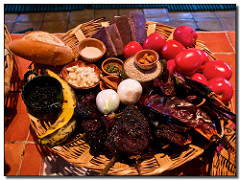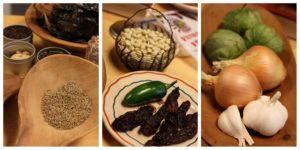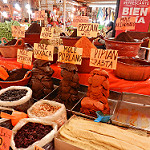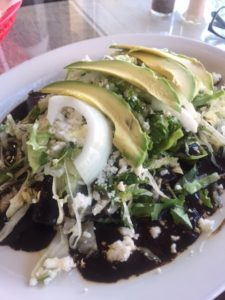
Photo courtesy of Waywuwei (Flickr CC)
Mole Mexicano in my opinion is a delight for the all the senses and is a quintessential Mexican dish. Many people think of Mexican food as a quick cheap bite that is bathed in a one dimensional red chile sauce and heaped with bright orange cheddar cheese. Or others think if it as a quick meal one gets from a drive-through window to help soak up a night of alcohol drinking. Yet Mexican cuisine is rich in history and tradition and many times origins of recipes are veiled in generations of mystery. Mole is a treat in so many ways; aromatically one gets potent smells of chiles and subtle perfumes of cinnamon and clove. Visually one gets glistening views of a deep, dark, velvety sauce bubbling away over a low flame. If done the traditional way, audibly one can hear the grinding of nuts and chiles between a metate y mano (mortar and ground stone) or a laboring blender if done in the more modern style. Yet the most delightful gift to the senses is when one tastes the complex dish, collectively all the ingredients complement each other and offer the person consuming it a remarkable experience.

Photo courtesy of Sharron McClellan (Flickr CC)
Historically though there is not a definitive origin as to where mole came from, although the most well known moles are from Puebla or Oaxaca which lead to the names mole Poblano or mole Oaxaqueño. Oaxaca is famous for their mole and is said to formally have 7 moles; Negro, Rojo, Coloradito, Amarillo, Verde, Chichilo and Manchamanteles. In Mole has many Flavors, Mothers; the two more famous legends of the origins of mole are described. There it is described that for the variation from Puebla, “the story goes that in the late 17th century, the Dominican sisters of the Convent of Santa Rosa in the city of Puebla heard that the archbishop was to pay a visit. The sisters had to scramble to put a meal together and gathered the ingredients they had — dried chili peppers, chocolate, old bread, nuts and more — to make a sauce for wild turkey. The meal was such a hit with the archbishop, legend has it, that mole became a symbol of Mexican cuisine (up there with the taco).” There are also linkages to pre-Hispanic Mexico. The other legend states that mole came from pre-Hispanic times and that Aztec king, Moctezuma, thinking the conquistadors were gods, served mole to Hernan Cortez at a banquet to receive them. This story probably gained credibility because the word mole comes from the Nahuatl word “milli” which means sauce or “concoction”. Another connection could be that chocolate was widely used in pre-Colombian Mexico, so people jumped to that conclusion.

Photo courtesy of Waywuwei (Flickr CC)
Traditionally it is a very laborious dish to make being that the rich sauce, or mole, can at times contain well over thirty ingredients and for this reason, the meal is commonly served at celebratory type events. Weddings, quinceañera, baptisms all commonly have the famous manchamanteles (tablecloth staining) served. It is called this, as it is virtually impossible to not stain either the tablecloth or the clothing one may be wearing while enjoying such a delicious meal. A Los Angeles restaurant I found that serves several variations of mole is located in East Los Angeles and is named Moles La Tia. There one can find all colors of mole with varying flavors that patters the landscape of central and southern Mexico. Moles vary and some are made sweeter or spicier than others and much of this depends on the region of Mexico it’s from, where ones family is from or also highly dependent on the recipe that has been passed on from generation to generation which at times tend to morph. In our family the recipe my mother utilized was slightly sweet and smoky and thoroughly delicious. My mother grew up very poor in Mexico and was raised by her aunt (my grandma Pancha) since her birth mother died when she was a mere two years old. My grandma was indigenous to the area of Nayarit Mexico and made a living by selling food in makeshift sidewalk cafes. Literally she would travel with her pans and set-up shop in small towns. This was in the 1930’s era in Mexico when roads and highways (I use the term roads loosely) were being built and my grandmother would travel the route of the progressing roads to cater to the single men laboring to build them. Essentially my mother learned to cook from a very early age due in part of the necessity to assist her mother. At the age of seventeen my mother got the opportunity to go to Mexico City to assist an affluent engineer’s wife and also assisted in the kitchen, which is why I feel she was able to learn a variety of dishes. I recall some deviled ham stuffed potatoes served in light tomato broth but I digress. Back to mole, certainly the recipe my mother learned was more complex since certain modern shortcuts had not been invented when she was a young girl and most of the time chiles, nuts and seeds were ground by hand. Although not as lengthy and complex as some of the recipes from old Mexico, my mother’s recipes is simple as the following describes and includes pre-mixed Mole Doña Maria invented in 1968.
Ingredients:

Photo courtesy of Leslie Seaton (Flickr CC)
- 1 whole chicken (or the preferred pieces/parts)
- 1 white onion (diced)
- 1 Cinnamon stick
- 2 whole cloves
- 1 tomato (coarsely chopped)
- ½ clove of garlic (minced)
- ½ teaspoon of cumin
- 1 slide of day old French bread (cubed)
- ¼ piece of Mexican chocolate (Ibarra or Abuelita)
- 1 teaspoon roasted peanuts or peanut butter (optional)
- Doña Maria prepared mole (eliminate the need to roast and grind multiple types of dry chiles)
- Toasted sesame seeds (optional)
Preparation:
Boil the chicken pieces in water and season to taste, as the cooked chicken will be added to the sauce later (do not discard the chicken broth).
Sauté in a mild flavored oil (canola or grape seed) all of the following: whole cinnamon stick, cloves, tomato, cumin, onion, cubed pieces of bread and Mexican chocolate. Once the ingredients have been cooked, add them all to the blender and add enough hot chicken broth to start the blending process. (DO NOT seal the blender as the hot steam may cause a hazard). Add ½ the jar of mole and salt to taste. Continue to add liquid until the puree looks velvety smooth and is thick. Once the desired consistency is achieved, pass the pureed sauce through a strainer into a hot saucepan, which has been lightly oiled (careful as sizzle will occur as the sauce is added to the pan). Bring the sauce to a simmer and then add the warm or hot pieces of chicken to the sauce and coat. Once plated, sprinkle with sesame seeds for garnish.
The recipe I shared is actually found hand-written by my eldest sister who took the time to document the recipe from my mother. As most mothers from an era gone-by, my mother did not follow recipes. She learned to cook my watching my grandmother add “a dash of this and a pinch of that” and over time my mother had perfected her own “sazon”. Traditionally in our home this plate was always served with Mexican rice, refried beans and corn tortillas although I have seen it served with white rice as well. Although the recipe may seem lengthy, as mentioned others contain numerous more ingredients and hours of preparation. In browsing Mexican Cookbooks for American Homes by Josefina Vazquez de Leon, there are descriptions of turkey mole, green or white mole and one of them has twenty-three ingredients and some referenced can have as many of twenty types of chiles! Being that my mother now eighty-one and suffering from Alzheimer’s no longer has the ability to cook and her mole is now a fragrant and fading memory that still warms my heart. I have taken it upon myself to find a mole comforting and inviting in place of hers. A place I came across on Yelp is called Moles La Tia Maria in East Los Angeles. This establishment reinforces the diversity of the Mexican culinary breadth. In this restaurant they have moles of all colors; red, black, green and even white which they call “Velo de novia” (bride’s veil). I’ve had shrimp bathed in a tamarind mole sauce as well a more traditional ones closer to what my mother would prepare. They also have a deep smoky black mole very traditional in the area of Oaxaca Mexico, which is located in the southern region of the country. I had the privilege of traveling to Oaxaca many years and ago and was able to experience true Mole Oaxaqueño. I enjoy mole so much that I would even have it for breakfast in a local central market or “Mercado”. I knew mole was a laborious preparation but knew nothing about it being a paste.

Photo Courtesy of Travis (Flickr CC)
Walking through the aromatic central market the labyrinth of aisles are tight with all type of goods; fruits, vegetables, meats and spices. Yet some of the more intriguing to me were the wide mouth baskets filled with paste the texture of molding clay. These baskets help rich colors of mole in red, yellow and green as well as deep velvety black mounds of smoky mole paste. Sitting amongst the locals my breakfast at the market counter would start with café de olla sweetened with piloncillo (coffee with dark cone sugar) then scrambled eggs bathed with black mole sauce topped with fresh cheese and of course the obligatory hand-made masa tortillas. Mole is versatile and in reality is really just the sauce which can be served over a variety of foods. Besides being slathered over eggs, one can also enjoy enchiladas de mole, which essentially are enchiladas bathed in a rich mole sauce. Recently I enjoyed chicken enchiladas at my favorite local spot for mole named El Jacalito Oaxacqueno in Lomita. Their shredded chicken enchiladas are dressed with a deep, rich, black mole and garnished with fresh lettuce, onions and avocado. Absolutely delicious, though different from the mole my mother prepared, the mole there transports me to the fragrant and bustling central market in Oaxaca which seems a world away but I easily go there in Lomita.


References:
Aztechistory.com http://www.aztec-history.com/moctezuma.html Accessed 11/26/16
Aztechistory.com http://www.history.com/topics/exploration/hernan-cortes Accessed 11/26/16
Bowman, Barbara.. “Piloncillo Mexican Brown Sugar”, Web. 26, Nov. 16. http://www.gourmetsleuth.com/articles/detail/piloncillo Accessed 11/26/16
Barclay, Elza, and Karen Castillo Faran. “Mexican Mole Has Many Flavors, Many Mothers.” NPR. NPR, 13 Jan. 2013. Web. 26 Nov. 2016. http://www.npr.org/sections/thesalt/2013/01/18/165494749/mexican-mole-has-many-flavors-many-mothers.
Doctoroz.com http://www.doctoroz.com/recipe/manchamanteles-chile-fruit-mole Accessed 11/26/16
Herdeztradition.com. http://www.herdeztraditions.com/dona-maria-products/dona-maria-mole-original/ Accessed 11/26/16
Hood, G. William. “Café de Olla”. 25, Aug. 2013. Web 26. Nov, 2016 http://universaldomainexchange.com/vivacue2/cafe-de-olla/
Indians.org http://www.indians.org/welker/nahuatl.htm Accessed 11/26/16
Kapadia, Jess. “The 7 Mole of Mexico.” Food Republic. 15, Aug. 2012
http://www.foodrepublic.com/2012/08/15/the-7-moles-of-oaxaca
Mexican Cookbooks for American Homes by Josefina Vazquez de Leon, 12th edition 1979
Mexico Online. http://www.mexonline.com/molepoblano.htm Accessed 11/17/16
Moctezuma: http://www.aztec-history.com/moctezuma.html Accessed 11/19/16
Visit Mexico. http://www.visitmexico.com/en/puebla Accessed 11/17/16
Visit Mexico. http://www.visitmexico.com/en/oaxaca Accessed 11/17/16
Wikipedia, The Free Encyclopedia. https://en.wikipedia.org/wiki/Nayarit Accessed 11/26/16
Wikipedia, The Free Encyclopedia. https://en.wikipedia.org/wiki/Mole_sauce Accessed 11/17/16
Wikipedia, The Free Encyclopedia. https://en.wikipedia.org/wiki/Metate. Accessed
Yelp.com. https://www.yelp.com/biz/el-jacalito-lomita Accessed 11/26/16
Yelp.com. https://www.yelp.com/biz/moles-la-tia-los-angeles?osq=mole Accessed 11/26/16
